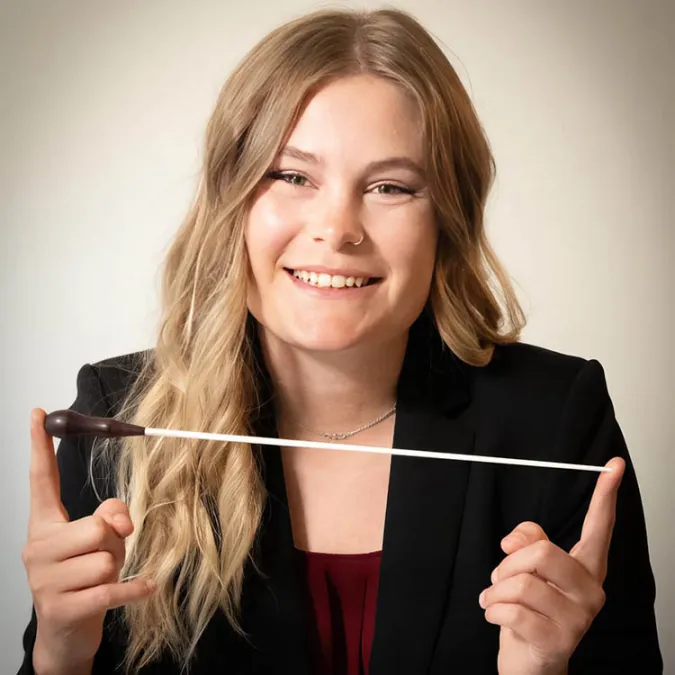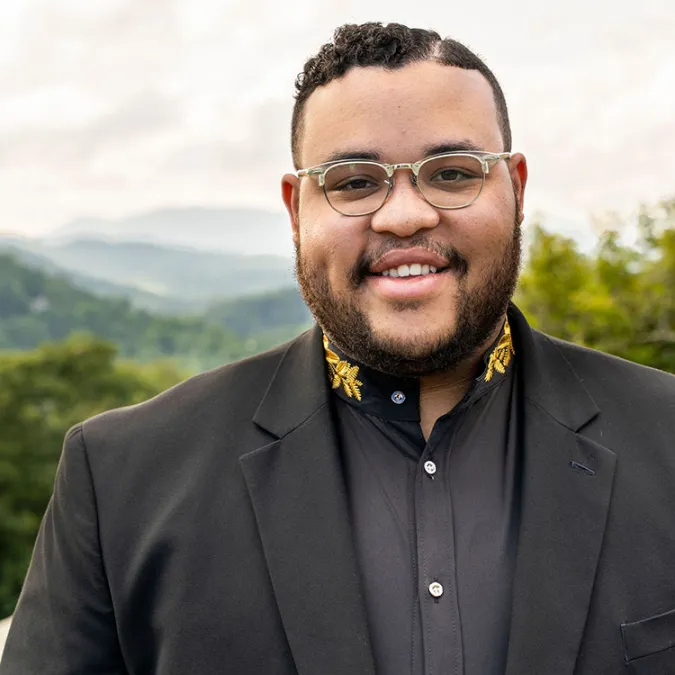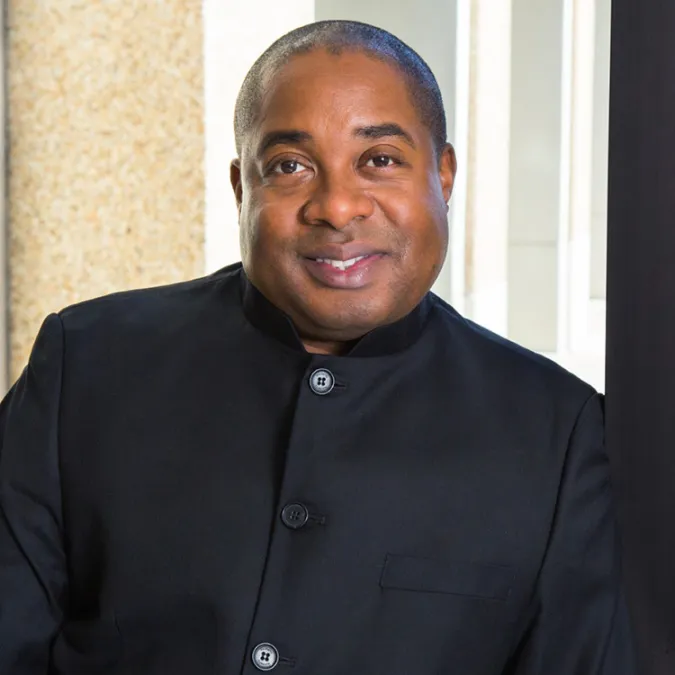Cliff Croomes, conductor
This concert will last about 90 minutes with one intermission.
Please silence your electronic devices.
Photography, video, or recording of any part of this performance is prohibited
Program
Steven Bryant
In this Broad Earth
Emily Warren, conductor
Kelijah Dunton
Letters
Charles Carter
Overture for Winds
Kevin Day
Capricho
T.j. Anderson, conductor
intermission
Camille Saint-Sëans
arr. Jones
Le Carnaval des animaux Suite
Introduction et marche royale du lion
Aquarium
Le cygne
Finale
Leonard Bernstein
trans. Stith
Three Dance Episodes from On the Town
The Great Lover
Lonely Town: Pas de Deux
Time Square: 1944
About the Program
Program notes by Mark Bilyeu
Steven Bryant
In This Broad Earth (Brass Ensemble Version)
Born May 28, 1972 Little Rock, Arkansas
Composed 2017
Premiered February 4, 2017, Durham Medical Orchestra Brass and Percussion, Durham, NC
Duration 2 minutes
Steven Bryant Steven studied composition with John Corigliano at The Juilliard School, Cindy McTee at the University of North Texas, and Francis McBeth at Ouachita University. His seminal work Ecstatic Waters, for wind ensemble and electronics, has become one of the most performed works of its kind in the world, receiving over 250 performances in its first five seasons. In 2015, the orchestral version was premiered by the Minnesota Orchestra. The son of a professional trumpeter and music educator, he strongly values music education, and his creative output includes a number of works for young and developing musicians. His work for brass ensemble In This Broad Earth is a reworking of his full band work of the same name, inspired by a trip in the Austrian Alps. Included as the work’s inscription is a quote from Walt Whitman’s poem “Song of the Universal” :
COME, said the Muse,
Sing me a song no poet yet has chanted,
Sing me the Universal.
In this broad Earth of ours,
Amid the measureless grossness and the slag,
Enclosed and safe within its central heart,
Nestles the seed Perfection.
Kelijah Dunton
Letters
Born 1999, New York City, New York
Composed 2021
Duration 7 minutes
Brooklyn native Kelijah Dunton began serious music study in high school as an alto saxophonist, and he continued to play with the ensembles of the Metropolitan Music Community. He is a self-taught composer who has been shaped by the diversity of the neighborhoods he has lived in (Williamsburg, Bushwick, and Crown Heights), and his memorable experiences in his high school band. His 2021 work Letters was commissioned by The College Band Directors National Association. He describes it as "A piece representing overcoming a romantic betrayal. My goal was to illustrate the concept as if it was a story. The 'story' of the piece is 'told' from the lens of the person who was betrayed by their partner. The piece goes through several iterations of the same melody but each time it's different, taking on a different identity entirely. Sometimes nostalgic and reminiscent, to bitter, menacing, full of malice and regret.”
Kevin Day
Capricho
Born February 23, 1996, Charleston, WV
Composed 2024
Premiered October 26, 2024, Minnesota Symphonic Winds, Kevin Day, conductor
Duration 6 minutes
Kevin Day is a composer, conductor, producer, and multi-instrumentalist on tuba, euphonium, jazz piano and more, whose music often intersects between the worlds of jazz, minimalism, Latin music, fusion, and contemporary classical idioms. His father was a prominent hip-hop producer in the late-1980s in Southern California, and his mother was a sought-after gospel singer from West Virginia, singing alongside the likes of Mel Torme and Kirk Franklin. Day’s music has been performed across the globe from Carnegie Hall to Russia’s Rachmaninov Hall, and by organizations such as the Boston, Detroit, and Houston Symphonies. Capricho was commissioned by the Minnesota Symphonic Winds and conductor Timothy Mahr alongside a consortium of 38 participating organizations from eight states and three countries. The title translates to “whimsical or fanciful” has march-like elements, but keeps the listener (and performer!) on their toes with sudden shifts and changes.
Charles Carter
Overture for Winds
Born July 10, 1926, Ponca, OK
Died December 11, 1999, Tallahassee, FL
Composed 1959
Duration 4 minutes
Charles Carter studied music at Ohio State University and Eastman School of Music before moving back to Ohio and beginning a career as a government employee. In 1951, he began arranging music for the Ohio State marching band, and in 1953, the marching band legend Manley Whitcomb offered him a job serving as his assistant at Florida State University. What followed was a 43-year career for Carter who continued to arrange alongside crafting original compositions. His Overture for Winds was given its title by the publishers, and is one of his most frequently-performed works.
Camille Saint-Saëns
Le Carnaval des animaux Suite
Born October 9, 1835, Paris, France
Died December 16, 1921, Algiers, Algeria
Composed 1886
Premiered March 3, 1886, Paris, France
Duration 20 minutes
Camille Saint-Saëns was many things: an organist, a composer, a poet, playwright, astronomer, philosopher, and an animal rights activist. Most notably, he decried the unrestricted hunting of the African elephants, writing in a 1905 letter that “The extermination of valuable rare animals is a deplorable thing, which, in my humble opinion, intelligent people should oppose with all their might...” Twenty years before penning that letter, he crafted what he considered a rather silly work: a set of miniatures depicting animals for an Parisian Mardi Gras party. Originally conceived for two pianos and a cadre of other instruments (including a glass harmonica), he titled the work The Carnival of the Animals: A Grand Zoological Fantasy (Grande Fantaisie Zoologique), and went to great lengths to ensure it was never heard in public during his lifetime. Despite these efforts, the work has become nearly ubiquitous to our lives—from the graceful and melancholy swan, to the glimmering and mysterious “Aquarium,” to the final movement’s joyful culmination we now exclusively associate with yo-yo-wielding flamingos thanks to Disney. Despite his best efforts, we now enjoy the fullness of Saint-Saëns’ output, from the serious to the silly to the sublime—all found here within his carnival.
Leonard Bernstein
Three Dance Episodes from On the Town
Born Month, August 25, 1918, Lawrence, MA
Died Month, October 14, 1990, New York, NY
Composed 1944
Premiered February 3, 1946, San Francisco Symphony, Leonard Bernstein, conductor
Duration 10 minutes
The idea for Leonard Bernstein’s On the Town emerged in 1944, just one year after choreographer Jerome Robbins crafted a ballet he called Fancy Free, which he had set to Bernstein’s music. The ballet scene involved three male sailors in search of companionship from the opposite sex while they are back on land for a short period. After the ballet’s success, Bernstein and Robbins convinced their friends, the writing duo of Betty Comden and Adolph Green, to craft a book and write song lyrics. What resulted was the Broadway musical On the Town, which was later adapted into a 1949 movie starring Gene Kelly and Frank Sinatra. Bernstein crafted three dance episodes from the original Broadway score for concert use:
The first episode is Dance of the Great Lover, in which the romantic sailor Gabey falls asleep on the subway and dreams of sweeping Miss Turnstiles off her feet; the effervescent music underlines Gabey’s naiveté as well as his determination.
In the second episode, Pas de Deux, Gabey watches a scene, “both tender and sinister, in which a sensitive high-school girl in Central Park is lured and then cast off by a worldly sailor.” This is set to Lonely Townthsp—thspone of Bernstein’s greatest tunes, worthy of his friend and mentor Aaron Copland in its air of reflective melancholy.
The finale, Times Square Ballet is described by Bernstein as “a more panoramic sequence in which all the sailors congregate in Times Square for their night of fun.” Part of the action takes place in the Roseland Dance Palace, with music to match. The famous “New York, New York, it’s a helluva town” theme makes a cameo appearance.
About the Artists
Emily Warren

Emily Warren attends The University of Texas at Austin, where she is currently pursuing a doctor of musical arts degree in wind conducting. As a graduate teaching assistant, she works with the university’s athletic and concert bands, assisting with administrative duties and conducting the ensembles. Additionally, she teaches courses in conducting and wind band literature. Prior to her graduate studies, Emily lived in Massachusetts where she spent four years as a public school music educator. She is a specialist in electroacoustic repertoire for wind ensemble and has been invited to present her research internationally, most recently at the IGEB (International Society for the Promotion and Research of Wind Music) conference in Valencia, Spain. Emily holds a bachelor's degree in music education from Indiana University and a master's degree in wind conducting from the University of Kansas, where she studied under the direction of Dr. Paul Popiel. She is an active member of various professional music organizations, including CBDNA, TMEA, IGEB, and is an honorary member of Kappa Kappa Psi.
T.J. Anderson

T.j. Anderson (he/him) is currently pursuing a Doctor of Musical Arts Degree in Wind Conducting as a Graduate Teaching Assistant at the University of Texas at Austin. He earned his Bachelor’s Degree in Music at Coastal Carolina University, focusing on percussion under the mentorship of Dr. Jesse Willis. T.j. continued his education by pursuing a Master’s Degree in Instrumental Conducting at Appalachian State University. There, he studied primarily with Dr. John Stanley Ross. As a graduate teaching assistant, T.j. made contributions to university bands, teaching conducting, band literature, and band methods courses. He also worked with the Marching Mountaineers as a winds and percussion instructor/arranger and served as Musical Director for the Appalachian Concert Band. In addition to his academic pursuits, T.j. has held leadership roles as Artistic Director and Conductor of the Festive Brass and Assistant Conductor of the Carolina Master Chorale. He is an active member of various professional music and education organizations and has been recognized as an Honorary Brother of Kappa Kappa Psi, Phi Mu Alpha Sinfonia, and a Sigma Alpha Iota Friend of the Arts.
Cliff Croomes

Cliff Croomes serves as the associate director of bands and director of the Longhorn Band at The University of Texas at Austin. Prior to this appointment, Croomes was the assistant director of bands at Louisiana State University and the music director and principal conductor of the Civic Orchestra of Baton Rouge. Previous to his appointment the faculty he studied at LSU for his Master of Music and Doctor of Musical Arts degrees. Dr. Croomes earned his Bachelor of Music Studies from The University of Texas at Austin and is an alumnus of the Cavaliers Drum and Bugle Corps from Rosemont, Illinois. He has performed with ensembles throughout the United States, London, Paris, Switzerland, Germany, Italy and consulted throughout Japan. Dr. Croomes holds an endorsement with Innovative Percussion Inc. and is a founding board member of the composer diversity initiative “And We Were Heard” as well as a member of the Dr. William P. Foster Project advisory board. Croomes also holds an honorary membership in Kappa Kappa Psi.
symphony Band
Flute
Gerardo Ayala
Cameron Farley
Zachary Gray
Chan-hee Kim
Holly Livingston
Oboe
Tara Tran-Huu
Clarinet
Toby Acfalle
Georgia Castillo
Emely Flores
Michael Golston
Thompson Le
Lyna Mai
Adelyn Rusli
Bassoon
Elijah Bergstrom
AB Brown
Naomi Kitamura
Darren Tea
Saxophone
Ben Crowley
Austin Davidson
Nigel Duplessis
Brandon Kusaj
Chantal Lee
Sam Striklin
Horn
Zachary Greer
Tomo Umetani
Ashley Young
Trumpet
Brett Harrington
Christopher Ray
Trombone
Jan Campos
Nicholas D’Andrea
Antonio Gamez
Joshua Gault
Hunter Irwin
Hudson Pedrotti
Landon Reimer
Benjamin Valliere
Konner Wetterstrom
Euphonium
David Barragan
Casey Hawthorne
Andrew Shaffer
Tuba
Carter Eason
Jeffrey Fields
Samantha Yanez
Percussion
Jackie Garcia
Victoria Garcia
Daniel Hernandez
Ty Keller
Caleb Koscinski
Jacob Laguna
Joel Rodriguez
Double Bass
Reilly Curran
Keyboard
Mingchen Chu
Event Details
Free admission


